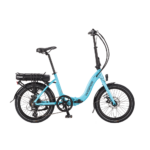I don't really know anything about the TransX Gryphon other than the easily available information, but we are being overwhelmed by all the new crank units now, rather too many for the market now I think. Panasonic, Yamaha, Bosch, Daum, Pacific, TransX, Kalkhoff etc. The use of square and triangular section frame tubes on the Gryphon seems a bit gimmicky to me, no perceivable gain and possibly weaker.
Back to the distribution of power between rider and motor, the Swizzbee system is interesting, now out of production but an expensive variant made in the USA under the Dolphin name by Izip.
In this, the rear hub is effectively a differential like that in cars, but used in reverse. Instead of the crown wheel sending variable drive from the propshaft to two half shafts and the rear wheels, the half shafts are the hub inputs, one side from the cyclist, the other side from the motor, and the resulting inputs summed into the hubshell and therefore the wheel.
You can see from this that the input from either rider or motor are infinitely variable in proportion.
In the practical realisation of the Swizzbee, the right hand input is a derailleur cassette, the left hand input a belt drive from a 270 watt Heinzmann motor mounted in the top of the rear frame triangle just below the saddle area and cowled in with the battery and controller. The motor is throttle controlled. Below are two photos of the bike, and below those some further information links:
The diagram in the webpage from
this link shows and briefly describes this arrangement designed by Michael Kutter of Switzerland, bicycle mounted.
The diagram in the webpage from
this link shows and describes an as yet unrealised variation in which the output of an integrated hub motor is summed with the cyclist's derailleur input.
.








